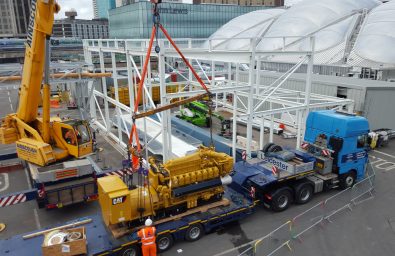
Combined Heat and Power is a long term sustainable approach to power consumption. Qsustain with its partners took on the challenge to meet the demands of the new central transport hub.
challenge
The expansion of the station concourse and additional lifts and escalators will mean that we will need nearly double the amount of power. So, in 2009, Q Sustain working for Network Rail commissioned the lead design and engineering consultant, Atkins to carry out a Low and Zero Carbon (LZC) study for the project.
Exploration of various renewable and low carbon technologies ranging from Ground Source Heat Pumps (GSHP), Biomass boilers, and Photovoltaic (PV) to cover 2,000m2 around the South of the station façade. Using an existing city centre location meant many constraints excluded the use of many technologies such as Biomass and wind.
solution
When PV’s were discounted due to the John Lewis development on the South Side removing the proposed PV area, Q Sustain working for Network Rail actively pursued the option of a Combined Heat & Power (CHP) scheme to provide the station with electric from gas and also look at options of connecting into the local district heating network to the North of the station. This would reduce carbon emissions from site micro generation, as opposed to traditional power station generated grid electric, reduce transmission losses and use the waste by-product of heat that is normally lost in the cooling towers of old power stations. The preferred bidder, Cofely were also very keen to use the subterranean network beneath the station to supply the south of the city and avoid disruption around the city centre.
The dilemma for Network Rail for using a CHP system was that the station demand profile was more electric intensive than heat. A heat partner was required to utilise surplus heat generated from the CHP plant and John Lewis was an ideal candidate being attached to the south of the station with its biggest store outside London.
With the inclusion of John Lewis agreeing to sign up to a heat agreement with Cofely, a carefully co-ordinated agreement was created that acquired simultaneous signing of Energy Supply Contracts.
- Once key partners and an outline scheme were identified, the major challenges of finding a location for a proposed 1.6MWe engine and planning the pipework routes through the station and John Lewis without disrupting a complex programme of works around the station redevelopment is a key challenge. Identifying the location of the plant to satisfy The
- Clean Air Act and avoiding a large chimney stack to satisfy local planning is just one of many obstacles the team have overcome in pursuing low carbon technologies.
- The installation of the CHP engine, associated plantroom and pipework led to many engineering challenges to install a significant array of heavy pipework that runs from the south Hinterland up John Lewis and along the station roof to meet the Cofely network on Stephenson Street. The connection to the wider Birmingham’s district energy network interconnection forms a single, giant, resilient district energy system for Birmingham.
results
- Network Rail’s first ever CHP plant and district heating connection for main train station.
- Contributes towards BREEAM credits for the project in the Energy and Pollution category
- Reduction of 3,000 Tons / CO2 / year predicted from the scheme
- Allowed the significant expansion of the Birmingham District Energy Network
- Pipework distribution planned via the tunnels below the station shall avoid disruptions around the city in expanding the network
- Opportunity to connect local building and residential developments reducing business energy costs and alleviate fuel poverty.
- Reduces the stations energy costs
- Contributes towards the city’s Carbon reduction strategy
- Allows adjacent John Lewis store to reduce carbon emissions from heating and hot water
- CHP recognised by EU Strategy on heating and cooling as capable of delivering significant energy and CO2 savings compared with separate generation of heat and power.
- Provides additional resilience from grid power.
